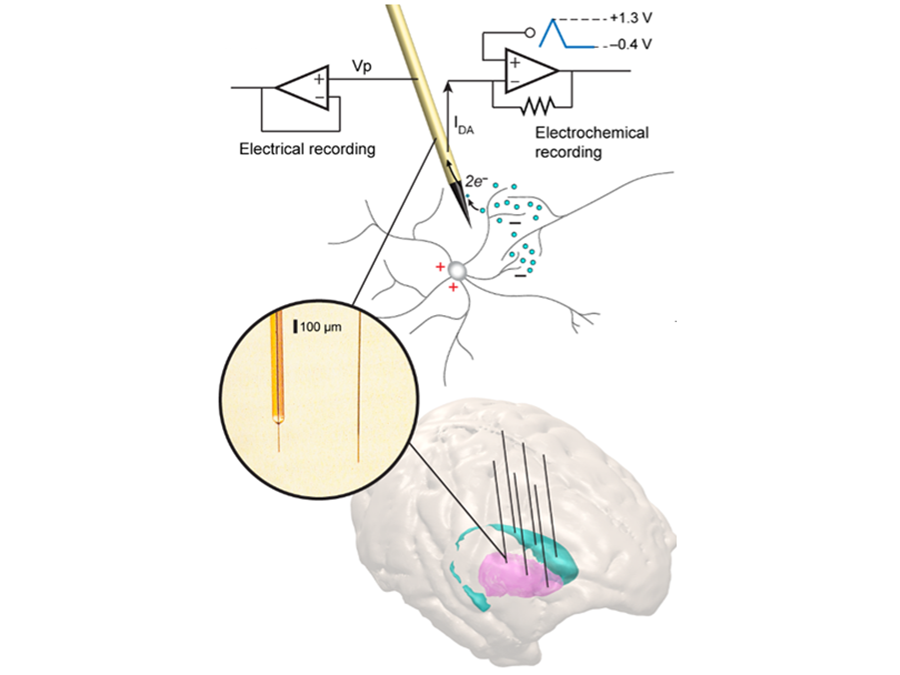Probing the deep mysteries of Parkinson’s disease
New study unraveled links between brain’s chemical and electrical circuits
Parkinson’s disease is a severe brain disorder that influences muscle coordination and induces notable tremors. Patients lose the ability to produce dopamine – a key chemical messenger in the brain’s reward system – leading to muscle tremors and altered mood. Also, beta brainwaves – electrical pulses affecting active thinking and synchronized brain activity – become overstimulated.
It is widely assumed that in Parkinson’s disease, a decrease in brain dopamine levels is linked to the massive increase in beta wave signals. But to date, no one has been able to measure chemical and electrical brain signals simultaneously to investigate this inverse relationship in non-human primates.
Now, researchers have developed a new dual brain-monitoring technique to do just that. Writing in the journal Science Advances, the researchers demonstrate for the first time that the interplay between dopamine and beta wave activity is much more complex than originally thought.
“Many elements had to come together for our team to simultaneously measure dopamine signals and brainwaves in real-time while a monkey performed a reward-orienting task,” says Ken-ichi Amemori, who is currently an associate professor, Kyoto University. For the study, he worked at the Massachusetts Institute of Technology, US, with Dr. Helen Schwerdt and Prof. Ann Graybiel. Amemori says, “The experiments were challenging, but we can now say that the apparent inverse correlation between dopamine and beta oscillations is not so clear cut.”
To measure both dopamine levels and electrical activity, the group implanted a pair of specialized fine electrodes deep into the brain of the macaque monkeys. The area of the brain chosen, the striatum, was the structure where dopamine loss occurs in patients with Parkinson’s disease. The dopamine probe produces a tiny electrical current to induce a chemical reaction of dopamine. By detecting the change in current, the probe could measure the dopamine concentration.
The study used a task in which monkeys performed the saccadic eye movement to obtain rewards. In each task, the monkey had to gaze for four seconds at a shape that appeared randomly on the left or right side of a screen. Each target was rewarded with either a small or large amount of liquid food. The side for the large reward was switched periodically. The two brain signals were measured before and during the four seconds of staring. They monitored reaction time and physiological signs, including licking rate, heart rate, and pupil diameter.
On average, the findings demonstrated an overall inverse link between dopamine production and beta wave activity: dopamine levels increased while beta wave activity decreased. However, a fine-detailed examination of the real-time data revealed that the results were dependent on task conditions.
First, in the caudate nucleus of the striatum, the two signals had different timescales. The beta wave signal fell rapidly, whereas the dopamine level gradually peaked over a few seconds. In line with the conventional view, the large dopamine level for a reward corresponded to the suppression of beta wave activity.
However, results were different in the putamen, another subregion of the striatum. The two signals were not always opposed and, in some cases, even changed in parallel. Surprisingly, the dopamine level was higher for the small reward, inconsistently with the theory of dopamine-beta antagonism, the researchers note.
These results suggest that the conventional rule of dopamine and beta might not have always been true. We need to look into the detail to have a more comprehensive rule to explain these phenomena, the researchers conclude.
Amemori says, “Chemical and electrical signals might be independently involved in both reward and motor processing, and their role may depend on the brain region. Our new dual chemo-electric recording and our findings could be profoundly useful for diagnosing and treating Parkinson’s disease and other neurodegenerative disorders.”
Paper Information
H. N. Schwerdt, K. Amemori, D. J. Gibson, L. L. Stanwicks, T. Yoshida, N. P. Bichot, S. Amemori, R. Desimone, R. Langer, M. J. Cima, A. M. Graybiel (2020). Dopamine and beta-band oscillations differentially link to striatal value and motor control, Science Advences, DOI: https://doi.org/10.1126/sciadv.abb9226
Writing: Nano Pico Science



